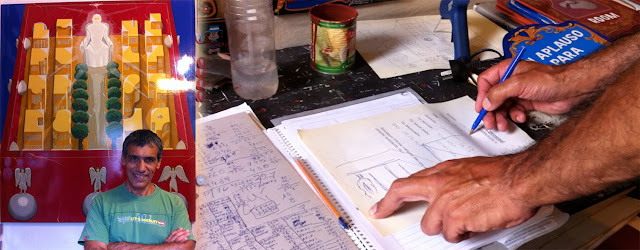Julio César Meloarejo
A challenge I've overcome: Life and death
A challenge I've overcome: Life and death
A dream for my future: To always be useful and transcendental
A hope for the global village: That everyone will be saved
Julio César was a brilliant storyteller. Quick to welcome us into the workshop space he was even quicker to start recounting the history of the origin of 'filetes porteños': a tale of two school age lads who were one day asked to paint a garage space on Calle Brasilia, the road marking the border of La Boca, in one simple colour. Left to their own devices, they not only painted the space, but also decorated indentations in the wall, and apparently when this was spotted it so impressed the owners that a new style of decorative pianitng was born: fileteando. (Julio César's recounting of the story was far more indepth, embellished and engaging, but this is the general jist - the important thing was that the unique style was born of a pair of little boys with unusually neat painting skills!

A devout Christian, Julio's answer of having overcome life and death he explained as having reached a point of not being afraid to die, a peaceful balance that he attributes to his faith. For his portrait Julio asked to be photographed in front of this painting (below left) which is his interpretation of the biblical vision of a city with twelve pearl gates where God is seated at the top of a row of fruit-bearing trees, which Julio explained as symbolic of humans whose fruit spreads the seed of the word of God.
Julio's religious conviction also served an important function in leading Julio to take up fileteando. Telling us his personal story, Julio drew us a diagram showing how his childhood family home was just next to a spot where hand-painted 'fileteado' carts parked up in front of horse-stables. Explaining that his family had been very poor, Julio told us he spent most of his free time as a child drawing, and that the painted signs of the carts oppostite stuck in his mind. Twenty odd years later, praying in church, the image of the hand-painted sings came into his minds eye, which apparently at first took him by surpirse, but later he interpreted as a sign, and he began to teach himself the techniques of fileteando porteño-style. The more normal route would be to be apprenticed to a filetedor, but having drawn all of his life, Julio found it easy to learn. With over 15 years experience he now runs courses in the techniques from his workshop, where he hand-paints originals which are then photographed and printed multiple times to be sold at affordable prices.
Daniela and my favourite signs from his wall display were:
*Sala de lectura (Reading room) with a painting of a toilet.
*La vida es una milonga. (Life is a milonga - tango gathering typical in Argentina, so more or less 'life is a dance party' - the Scottish equivalent would be 'life is a ceilidh')
Julio César, muchísimo gracias por todo que nos contó, esas historias fueran muy fascinante.
Suerte en todo su trabajo y proyectos.
Un abrazo.
:-)




No comments:
Post a Comment